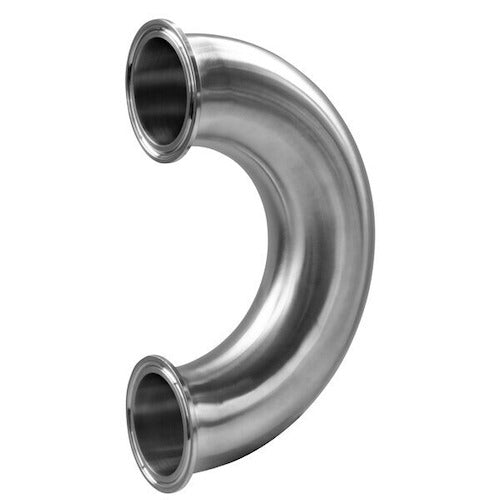Stainless Steel Tri-Clamp 180 Degree Return Bend
3-A Sanitary Certified
Material: 316L Stainless Steel
Connection Type: Tri-Clamp
Surface Finish: 32 Ra ID/OD
SKU: Item #: SS15CRB316L
In Stock
Couldn't load pickup availability

Collapsible content
Description
Easily change flow direction with our sanitary return bend.
Our sanitary tri-clamp 180° return bend is designed to route process lines in the opposite direction while maintaining a smooth flow.
The tri-clamp connections allow for quick installation and removal and provide a smooth seal, making it ideal for clean-in-place (CIP) systems. Tri-clamp returns bends are also called sanitary U-bends or return elbows.
We offer 316L stainless steel tri-clamp return bends in a variety of sizes.
Uses:
Fluid distribution and mixing
Bottling
Filtration processes
Steam transportation
Brewery
Dairy
Beverage
Fermentation
Pharmaceutical
Winery
And more
Specs

| Stainless Steel Tri-Clamp 180 Degree Return Bend, Polish ID/OD | |||||
|---|---|---|---|---|---|
| Tube OD (Size) | Length (A) |
Height (B) |
Weight (lbs) |
Part Number 304 SS | Part Number 316L SS |
| 1" | 3.000 | 2.500 | 0.51 | SS1CRB304 | SS1CRB316L |
| 1.5" | 4.500 | 3.500 | 0.89 | SS15CRB304 | SS15CRB316L |
| 2" | 6.000 | 4.500 | 1.49 | SS2CRB304 | SS2CRB316L |
| 2.5" | 7.500 | 5.500 | 2.09 | SS25CRB304 | SS25CRB316L |
| 3" | 9.000 | 6.500 | 2.99 | SS3CRB304 | SS3CRB316L |
| 4" | 12.000 | 8.625 | 6.35 | SS4CRB304 | SS4CRB316L |
*all measurements are in inches
304 vs. 316L Stainless Steel
304 and 316L stainless steels appear visually identical, but have distinct performance characteristics.
304 stainless steel contains approximately 18% chromium and 8% nickel, making it suitable for kitchen applications and indoor environments. It performs well under normal conditions but becomes vulnerable to corrosion when exposed to salt or harsh chemicals. This makes it the more economical option for standard uses where corrosion resistance is not a primary concern.
316L stainless steel contains 2-3% molybdenum in addition to chromium and nickel, providing superior corrosion resistance, especially against saltwater and chemicals. Furthermore, 316L has a lower carbon content than 316, increasing corrosion resistance and making it ideal for welding. While it commands a higher price point than 304, it is recommended for outdoor marine environments and food processing applications involving salt.
304 is useful for some standard applications, but for the highest level of durability and harsh environments or saltwater exposure, the additional investment in 316L stainless steel is justified for long-term success.
